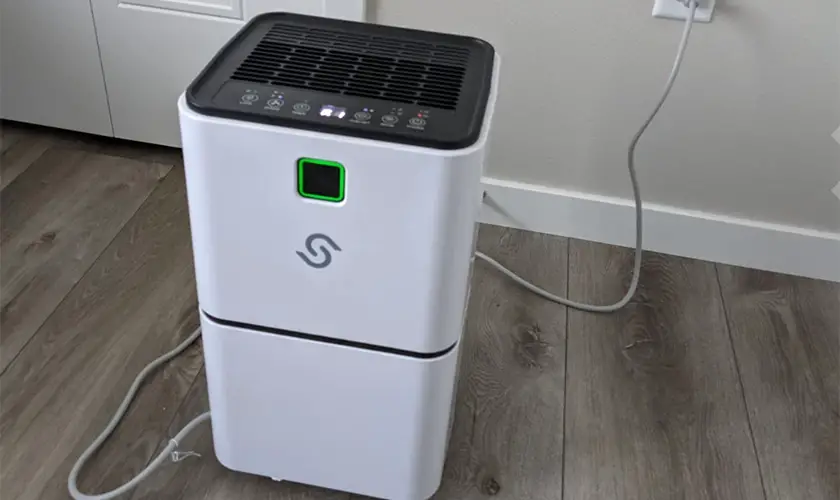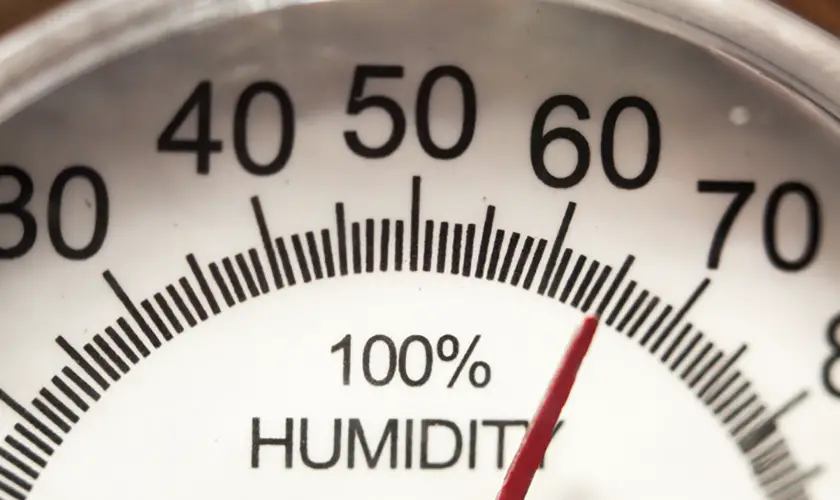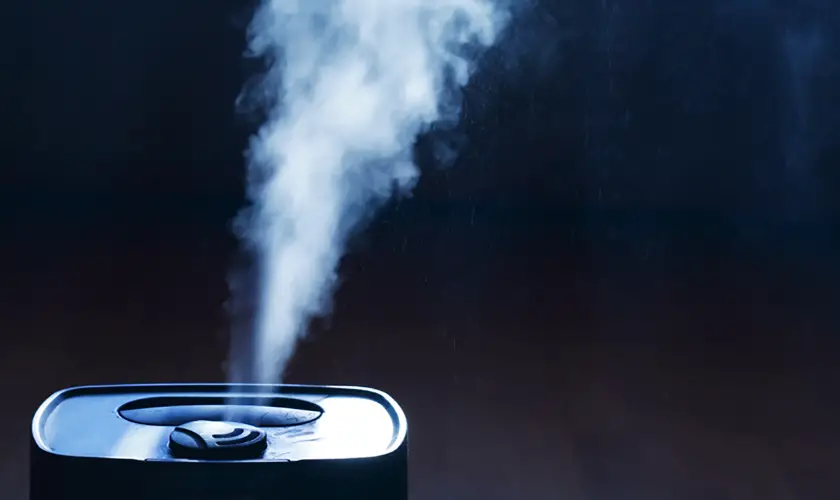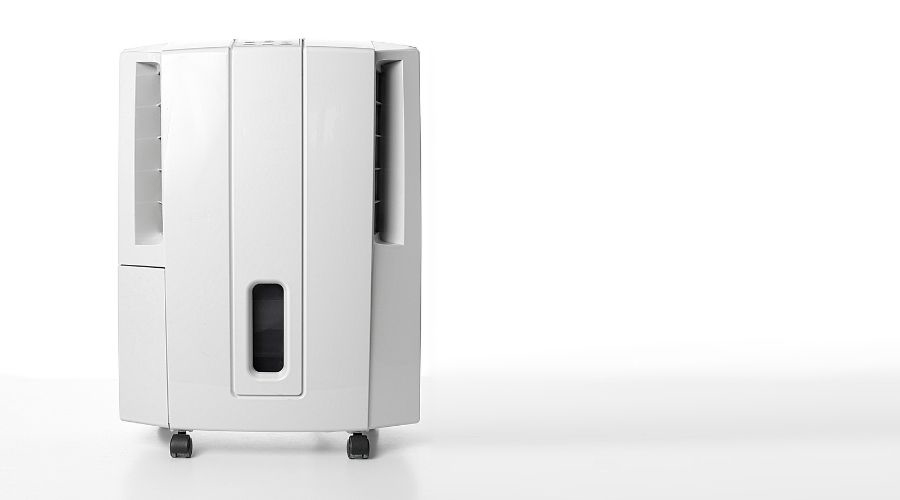
A dehumidifier is an electrical appliance that effectively regulates the humidity in the air. Excess moisture in your home or office may result in various disadvantages. These include musty odor, peeling paint, and centered and ceiling molds.
Dehumidifiers do not cause carbon monoxide. They’re electrical appliances that can improve air quality in a room. A dehumidifier is a practical appliance that reduces excess moisture in the air.
We have rounded up some information that will tell you whether a dehumidifier does not cause harmful carbon monoxide and whether you must be concerned about it. Keep scrolling for more!
Do Dehumidifiers Release Carbon Dioxide?
Dehumidifiers do not release carbon monoxide. Carbon monoxide is a byproduct of oil and gas burning partially.
Dehumidifiers work using the principle that they suck in moisture from the air in a room and release moisture-free air back out. There is no combustion of air with the use of dehumidifiers.
A dehumidifier helps reduce the air’s moisture, making the environment more comfortable to breathe freely. Dehumidifiers exist in different designs, with the most common being portable dehumidifiers. The main principle of working is, however, the same.
They are available in various sizes depending on the size of the room. Ultimately, you may also consider the extent of the problem before settling on the size of the appliance.
How Do Dehumidifiers Work?
The main principle of working is to remove moisture or humidity from the air. There are two easy techniques by which they can achieve this.
One is through the refrigeration technique, air gets cooled similarly to a refrigerator. The second technique involves the absorption of moisture into a drying material.
Below we will discuss in detail the two techniques of how dehumidifiers work.
1. Refrigeration
In refrigeration, warm and humid air gets sucked into the dehumidifier on one side of the appliance. Air is sucked into the dehumidifier by the electric fan that is present in the machine. The moist and warm air then passes over cold pipes in the dehumidifier, where a coolant circulates.
The moisture in the air slowly turns to liquid and flows into the pipes. The moisture-free air then passes over the compressor unit of the dehumidifier and goes back to its original temperature. The moisture-free air then flows out of the other side of the dehumidifier.
The moisture in the air that turns liquid flows down to a tray in the dehumidifier. When the tray is brimming, an electric switch triggers an indicator light to tell you that the appliance needs emptying.
2. Absorption
The absorption or adsorption technique is another simple principle of how some dehumidifiers work. Some dehumidifiers work by the use of water-absorption material that draws out moisture. Desiccant dehumidifiers are another word for these devices.
This technique draws moist air into the dehumidifier through a duct. The air then moves past a rotating wheel made of water-absorbing material. Moisture gets removed during this process. Dry air is then blown back into the room.
The process does not end here. The water-holding material then rotates over a heated space to allow it to dry. The process is made possible by using thermostats and humidity sensors.
What are the Available Dehumidifier Designs?
There are a variety of dehumidifier designs available in the market. They include portable dehumidifiers, whole-house dehumidifiers, heat pumps, and ventilation dehumidifiers.
In most cases, the option of your choice depends on the size of the dehumidifier you may need. Do you need a dehumidifier to use for commercial purposes or just for residential? These are some of the questions you may want to answer before opting for a dehumidifier.
Below is a detailed description of the available dehumidifier designs:
1. Portable Dehumidifiers
Portable humidifiers are one of the most common designs that you may find in many homes. They are often lightweight and inexpensive.
These dehumidifiers are either refrigerator-style or desiccant dehumidifiers. Because of their lightweight, they can easily transport from one place to another.
The design of portable dehumidifiers is such that they come in plastic material, making them lightweight. With proper care, they can last for a long time.
You may consider purchasing a portable dehumidifier for easy transportation from one point to another.
2. Whole-house Dehumidifiers
Whole-house dehumidifiers, unlike portable dehumidifiers, are fixed units and are more expensive. These dehumidifiers require a professional and centered installation to eliminate excess humidity or moisture.
3. Heat Pump Dehumidifiers
Heat pump dehumidifiers use the refrigeration method to remove excess moisture from the air. They use a fan to pull air into the unit, and condensed water can pour into a water tank drains via a hose.
A significant difference brought about by the heat pump dehumidifier is that air is warmed again before being blown back to the environment, making it drier than initially absorbed.
4. Ventilating Dehumidifiers
These dehumidifiers use sensors and an exhaust fan. They are not as effective as dehumidifiers designed to use refrigeration and absorption techniques. However, they are efficient in ensuring that some areas in the room are damper compared to others.
The sensor alerts you of a specified area that is more humid than the rest. You can turn on the ventilator to remove the moisture from the air.
What are the Factors to Consider when Choosing a Dehumidifier?
There are various factors to consider before choosing the right humidifier for you. The main one is the size of the dehumidifier. Other considerations include the technology used by the dehumidifier, their energy efficiency, and the principle behind their operation mechanism.
If your office or home is stuffy or musty, it shows that humidity levels in the room are very high. Various activities may result in moisture release into the air, which may be problematic.
These activities include running a washing machine, cooking, or operating an electrical appliance. Dehumidifiers are an easy solution to reduce moisture in the air, making it more comfortable to breathe.
Below is a detailed description of the factors to consider when choosing a dehumidifier:
1. Size of the Dehumidifier
It is essential to choose a dehumidifier that fits your space of operation. It is first necessary to understand the square footage of the room where you want your dehumidifier. The drying capacity can measure by the pints of water it can absorb for 24 hours.
Many dehumidifiers come with a manual that helps customers pick their preferred sizes. Always ensure that you purchase a dehumidifier with a higher capacity to create more space to harness moisture.
2. Humidity Control
Choose an automated dehumidifier that allows monitoring of humidity levels in the air. The optimal humidity level ranges from 40% to 50%.
You may choose a dehumidifier with an adjustable humidistat. This option allows you to adjust the humidity level to your desired level and maintain it.
3. Water Capacity
Before purchasing a dehumidifier, consider its bucket size. Dehumidifiers that have more giant buckets do not need to empty them often.
The more water a dehumidifier can extract, the more likely it may be costly. Most of the dehumidifiers with front buckets are easier to empty.
The portable dehumidifiers are such that they can self-drain water through a hose connection. However, placing the dehumidifier where the hose can quickly empty water, such as drainage or a laundry sink, would be best.
4. Noise Level
Noise is a nuisance, especially if it’s from a dehumidifier. It is essential to consider a dehumidifier that operates with low noise levels. It is crucial to test the noise levels of the dehumidifier before making your purchase.
5. Energy Efficiency
The dehumidifier ought to be energy efficient, meaning it consumes little electricity during operation. It allows you to save up on financial costs. An energy-efficient dehumidifier uses less energy and runs efficiently.
6. Defrost Features
Always opt for a dehumidifier that can efficiently work at lower temperatures. Consider purchasing a unit that has an automatic defrost feature. These features will save you the trouble of replacing the whole dehumidifier damaged by iced coils.
Can Dehumidifiers be Harmful?
There are various potential side effects of using a dehumidifier. Dehumidifiers can potentially make air extremely dry if you live in dry areas. However, it may cause conditions such as pneumonia to worsen.
Individuals who struggle with other conditions, such as eczema and acne, may be affected by flare-ups caused by an arid environment. These are some of the potential side effects of dehumidifiers.
If you use a dehumidifier correctly, there may be few adverse health effects. There are various ways in which you may use a dehumidifier and impose harm on your health, as seen below:
1. Misusing the Dehumidifier
Misusing the dehumidifier can lead to potential side effects. It is essential to follow instructions in the manual on how to use a dehumidifier. One common mistake often is leaving the windows closed while using the dehumidifier.
It is essential to allow air to flow freely to avoid dampness. Failure to do so may likely affect your health. The other mistake is failing to empty the dehumidifier bucket when full. Most dehumidifiers prevent the machine from working if the bucket is full.
If the dehumidifier bucket is left brimming, it may cause mold to grow on the dehumidifier. Molds may lead to various health problems, such as allergic reactions, breathing difficulties, and irritation.
2. Failure to Clean the Dehumidifier
It is not just the dehumidifier bucket that needs to be cleaned from time to time. You should clean every part of the dehumidifier regularly. Cleaning prevents moisture accumulation in the dehumidifier, particularly near the grills, filters, and coils.
Cleaning these parts prevents molds from forming inside the dehumidifier, which may eventually harm your health.
3. Working in a Space with Little Humidity
Dehumidifiers work best in an area that has excessive moisture. Low humidity levels are the number one cause of dry skin and sinuses, which may be problematic over a long period.
Places with low humidity tend to cause health issues, mainly targeting the respiratory tract. It is always essential to ensure that the dehumidifier does not completely dry the surrounding air.
Also, you are more likely to be affected by colds and flu in areas experiencing low humidity. Ultimately, some viruses are bound to thrive in moderate moisture areas. It is crucial to work with dehumidifiers in an environment with high humidity.
Can a Dehumidifier Set off a Carbon Monoxide Alarm?
Yeah, but the probability of this happening is very low. The appliance works by reducing the amount of water vapor in the air. There is no combustion process involved while using a dehumidifier.
Carbon monoxide detectors usually have difficulty distinguishing if the air particles are merely moist air or smoke, generating false alarms. Using a dehumidifier reduces excessive moisture in the air and prevents the detector from setting off.
However, various instances may cause your dehumidifier to set off a carbon monoxide alarm. Below is a detailed description of these instances:
1. Malfunctioning of the Dehumidifier
A malfunction in the dehumidifier may cause it to stop working as it should. If the humidistat breaks, the dehumidifier cannot remove excess moisture in the air.
Excess water particles in the air have the potential to trigger the carbon monoxide alarm. It is essential to regularly check if the dehumidifier is in proper condition to avoid false carbon monoxide alarms.
The humidifier may also malfunction due to moisture accumulation in specific appliance parts. Moisture accumulation can potentially cause molds in your dehumidifier, preventing its normal working.
Regular cleaning of your dehumidifier ensures the appliance is in good condition. Other common issues that may affect your dehumidifier are:
- A malfunction in the fan’s working
- Blockage in the airflow
- Overloading of the dehumidifier compressor
2. Defective Carbon Monoxide Detectors
If your detector goes off for no specific reason, your carbon monoxide detector may likely be defective. The internal sensors and wires of your detector may fail after a long period of using your detector, leading to a false alarm.
To avoid false alarms, it is essential to replace your carbon monoxide detector at least once every five years. Some carbon monoxide detectors have an expiration date that lets you know when you need to buy a new one.
Many carbon monoxide detectors may beep, indicating that the battery is low, which may be mistaken for carbon monoxide buildup. It is crucial to check the batteries of your detector regularly. You can do this after every six months.
3. Lack of Ventilation
When using a dehumidifier, it is necessary to allow fresh air into the room. Harmful gases can accumulate when a home or office is tightly closed in the presence of a dehumidifier, which may trigger the carbon monoxide detector.
Ensure that free air flows in and out of the room using a dehumidifier to improve ventilation.
The following are other considerations to prevent false alarms from your carbon monoxide detector.
- Purchase carbon monoxide detectors that meet safety and working standards.
- Always make sure that appliances are correctly installed according to the manufacturer’s instructions indicated in the manuals.
- Do not service appliances that use fuel without proper knowledge and skills. It is essential to always refer to the manufacturer’s manual when dealing with electrical devices at home or the office.
- Limit fuel-burning devices at home or office unless specifically used in an enclosed area.
- Avoid using gas appliances to heat your home or office.
- During renovations, always ensure that electrical appliances are not blocked by debris. Regularly check if the devices are properly working before using them.
- Regularly check vents to ensure they are not blocked by dirt or debris to allow air circulation in your home or office.
Conclusion
Excessive humidity or moisture can potentially cause various adverse effects in your home or office. If you struggle with high humidity levels in your home or office, you can consider purchasing a dehumidifier.
A dehumidifier is a superb appliance that provides comfort at home or the office. One of its best advantages is that the device does not produce carbon monoxide or carbon dioxide. You are thus guaranteed your safety when using a dehumidifier.






